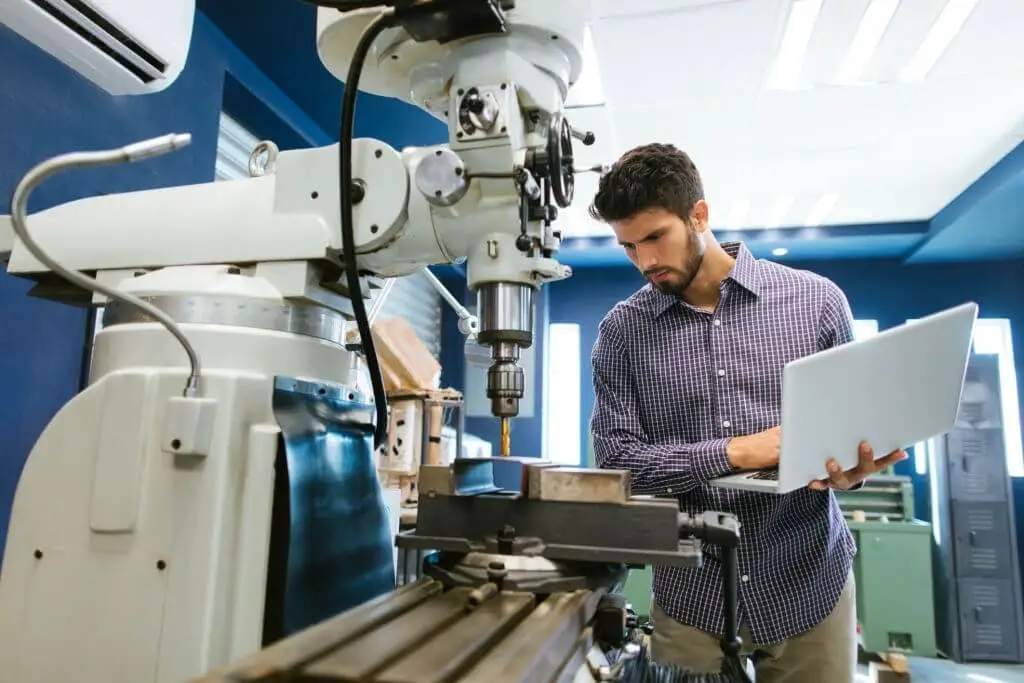
Do you want to buy the best laptop for engineering? It doesn’t matter what kind of engineering course you’ve taken, be it mechanical, computer science, or even civilian.
We have researched, reviewed, tested, and compared around 85 different laptops from different brands to help you find the best one.
The laptops we have listed will not only help you get through college but are ready for the future. It means that you will be able to use them even after college.
For example, during your work. Also, if you are someone who has already struggled with your old laptop and is looking for a laptop to go with you for years to come, then you are in the right place.
After researching several sleepless nights, going through their reviews and ratings, I have compiled a list of the best laptops for engineering students.
These laptops are powerful enough to handle any job intensive or engineering software like AutoCAD, MATLAB, Adobe Premiere, or Visual Studio without any rendering errors. So, without further ado, here are the 10 best laptops for engineering students in 2020.
In a hurry? Here are quick links to our top 7 recommendations for the best laptops for engineering students:
Below, we will compare all the laptops to see which ones are the best for engineering students.
Well, you can just buy the laptop that comes with the highest system specs and spend a whopping $ 3,000 or more. But that’s not the goal, is it?
Since it will not use all the resources. Being able to buy the one with a little more than the required specs can not only save you money, it can also strike a balance between budget and specs.
To help you strike a balance, we conducted research among different types of engineers (mechanical, computer, civil) and came up with recommended system specifications. Are here:
However, there are only a few possible contenders for the best laptops for engineering students, and the choice becomes more difficult when the price is taken into account.
Luckily for you, we are about to make your life easier. We have put together a list of the best. Now you can spend less time considering all your options and more time studying.
This section will find reviews of the best laptops for engineering students that you can buy on the market. So, without further ado, let’s get started!
We spent a lot of time and effort in compiling this guide. We spent 68 hours searching for the best laptops for engineering on the market and have used various sources, such as reviews and reviews from professional musicians, to bring you the information you need.
You can blindly trust us because the more research you do, the more knowledge you get. We research for our beloved controllers as the best.
Here, we will provide a review of the best engineering student laptops in detail so that you can buy knowing everything. Let us begin.
The HP Spectre x360 2-in-1 performance powerhouse. The laptop is available in 2 sizes, 13 and 15 inches. It is a well-built laptop with an Aluminum casing.
I found that the 13-inch version is a better fit for students over its sibling model, as it is lighter and easily fits in the bag, and can be taken anywhere.
[amazon fields=”B08121GR8S” value=”thumb” image_size=”large” image_align=”center” image_alt=”HP Spectre x360″]
It has a fantastic backlit keyboard and it also comes with an HP Tilt Pen which is more suitable for mechanical and civil engineers who enjoy taking notes or annotating their documents.
The laptop has an impressive battery backup and will give you up to 8 hours of system runtime when connected to a wireless network.
Generally, the HP Specter x360 laptop is a great device. And if you can get past some insignificant shortcomings, like its bottom 2.1-megapixel webcam, it will be a great choice for you.
Pros
Cons
The Asus Zenbook has the best design in 2020 according to the PCmag website and it’s hard to blame them. All-metal design with 95% screen-to-body ratio, edge-to-edge display, gold ASUS logo on the back makes it stand out.
[amazon fields=”B07W5XJ21H” value=”thumb” image_size=”large” image_align=”center” image_alt=”Asus ZenBook Pro Duo”]
The 15.6-inch 4K OLED display on the ZenBook Pro Duo offers crisp images. The 4k ScreenPad Plus is an added treat, allowing you to have a multi-window experience.
Also, both displays are touch-sensitive and can detect even faint touches. Fortunately, the manufacturer has included ASUS Pen for natural writing that is made of aluminum.
On top of that, the Intel Core i9 processor, 32GB of RAM, and the Nvidia GeForce RTX 2060 GPU will run engineering applications like CAD smoothly. Also, the 1TB SSD storage capacity makes it the best laptops for engineering students in 2020.
Moving towards the ports for secondary connections, you’ll find a Thunderbolt 3 port, a USB 3.1 Type-A Gen 2 port, and an audio jack on the right side.
While on the left side there are an HDMI 2.0 port and USB Type-A ports. However, the power settings and two 4k touchscreens come at the price of shorter battery life.
On average it can last up to 4 hours, which is acceptable, to be honest. So, if your top priorities are powerful performance, a large screen, and multitasking, ASUS Pro Due is definitely for you.
Pros
Cons
[amazon fields=”B07W5XJ21H” button_text=”Check Price on Amazon” value=”button”]
Microsoft’s Surface Pro 7 is the latest version of the award-winning surface series, which is sure to appeal to a variety of users.
Microsoft has tried to innovate and give the masses a completely new experience that partially delivers.
Looking for a professional-looking laptop for your engineering course? Well, this will be your best bet!
Every year Microsoft releases some of the most exceptional premium products.
The Microsoft Surface Book is no different. It is a lightweight, highly functional machine that you can easily take to your job site. It is a two-in-one device, so you can use it as a tablet or laptop.
The screen is detachable, making it even brighter when used in tablet mode. Also, it comes with the Surface Pen that feels like a real pen.
You can mark your documents in your actual handwriting, highlight important topics in your presentation, and jot down new ideas as soon as they occur to you.
This surface stylus sticks to the side of the laptop so you don’t have to worry about losing it.
The surface book is designed with magnesium, feels sturdy, and has a humble design. It is so well built that the screen and keyboard are almost the same weight, making it easy to handle.
Pros
Cons
Acer Predator Helios 300 is an indisputable choice for engineering students to run engineering-oriented applications at high speed.
The laptop is equally equipped for gaming and allows you to run the latest games without any errors.
This is a good looking laptop with the typical Acer gaming finish. Steep curves and slopes, with red plastic added here and there, give it a refreshing look.
The body is made entirely of plastic and feels good to the touch. There is plenty of room inside the Acer Predator Helios 300 for custom updates. The RAM can be expanded from 16 gigabits to 32 gigabits and the hard drive can be expanded to 2 terabytes.
This is the latest model in the Predator series and it doesn’t disappoint in terms of power. It’s armed with Nvidia’s 1660 Ti Geforce graphics card, a 144Hz IPS panel, and Intel’s latest 9th-gen i7 processor.
It has desktop specs at a much cheaper price. This is a true gaming display capable of giving you 70-80 frames per second, even in the heaviest games.
A good graphics card and high RAM are not only made for games, they are even more important when doing calculations, iterations, simulations on a machine. A high RAM will go through a program faster than a small one.
Pros
Cons
This Dell Inspiron i5577 is a very good looking product, it has a simple design in itself.
It is aimed at all engineering students looking to get their hands on a stylish laptop with impressive hardware components under the hood.
It has impressive specifications and is perfect for any student, especially mechanical engineering students.
The laptop comes with the 7th generation Intel i5 processor that can boost the turbo from the base speed of 2.8 GHz to 3.8 GHz, which is as fast as the old i7.
It can handle even the most memory consuming computer software such as Mathcad, CAD software, and all other popular mechanical engineering software such as VBA, Microsoft Excel, etc. easily.
With 8GB of RAM + 256GB of SSD, the laptop can handle just about anything, large data sets, intense gaming, HD video editing, and Photoshop. You will never be disappointed in any field.
It comes equipped with an ultra-fast 256GB solid-state drive. This SSD will save you time by reducing software installation time, performing quick antivirus scans, and reducing Windows boot time.
However, there is a problem, Dell has not provided any space inside the laptop to add another hard drive. But you can always buy an external hard drive to avoid the storage problem.
The Nvidia 1050 4GB graphics card is capable of handling even the most intense gaming sessions. The 15.6-inch FHD display has an anti-glare coating, so it doesn’t strain your eyes when you work continuously.
The keyboard feels great, there is very little travel when typing. The keys make minimal noise when pressed, in short, it’s perfect for typing or encoding.
Pros
Cons
The MacBook Pro is a similar device with high potential, housing an Intel Core i7 processor to power your work with ease.
The Hexa-core processor reaches up to 4.5GHz and provides more oomph due to Apple’s impressive thermal architecture that dissipates heat at a faster rate.
Apple’s proprietary Retina display has always been the highlight of its MacBook series.
Also, in this case, the Retina display offers extraordinary results with 500 nits of brightness for a 15.6-inch screen. This caveat is reinforced by a wide P3 color gamut that delivers truer images with the highest clarity.
Design is where Apple generally excels with a sleek, minimal theme.
The MacBook Pro perfects this by providing a polished gray finish with an Apple logo and a great port location to enhance the user experience.
Apple’s MacBook Pro can store up to 8TB, but this model comes with a 512GB SSD which is enough to satisfy a student’s requirements.
The DDR4 RAM in this model is 16GB, ensuring smooth multitasking and lag-free operation.
The new MacBook Pro is truly a beast in every sense of the word, delivering extreme performance and graphics with an impressive display.
It adds the Thunderbolt 3 port for maximum efficiency in external connectivity and provides a rich audio experience to boot.
Overall, it may be the best laptop for engineering students and engineers.
Pros
Cons
The Razor Blade 15 is a big machine, not in terms of size but in terms of specs. A 4.5 GHz six-core processor with 16 gigs of RAM makes for a very fast laptop.
The Razer Blade 15 is a great all-around device with great graphics and screen quality to ensure you can work with powerful engineering software with ease.
With a massive 16GB RAM storage and a speedy 4.5 Gigahertz six-core CPU from Intel, the Razer Blade 15 is a delight for all engineers. The laptop is useful for any engineering task as well as normal day-to-day computing operations.
The system comes in a protective all-black aluminum casing that is accented with a stunning green Razer logo that sits comfortably on the lid.
The customizable RGB lighting technology that comes with the laptop keyboard allows you to enjoy your computer operations in the dark while adding a personal touch.
The Razer Blade 15 is capable of handling all your graphics-intensive tasks, thanks to its top-of-the-line GeForce RTX 2060 graphics card from NVIDIA.
The laptop’s 144Hz monitor is capable of delivering top-notch graphics at an impressive 60 frames per second at all times to make every gaming task simple, smooth, and seamless.
For an engineering student, the Razer Blade 15 laptop will power all your digital projects and hardcore games without a hitch. You can even take advantage of the system’s additional 2.5-inch hard drive slot for extra storage space for your large files and documents.
The Razer Blade 15 doesn’t have any performance-hampering bloatware that is common in newer laptops. The only pre-installed software you will find on this laptop is the Synapse app, which allows the user to configure and customize the laptop’s keyboard RGB lighting technology.
Overall, you will get the most hits for your money when you buy the Razer 15 system.
And you can take our word for it; You can’t get an exceptional RTX graphics card and 144Hz panel in a system that’s the same price as the Razer Blade 15.
Pros
Cons
Searching for the best laptops for engineering students will become easier if you could keep a few points in mind to look at a laptop.
The article is a bit long, but remember that if you are a student, you will have to keep this laptop for four years.
If you’re not sold on the laptops I’ve recommended above, spend some time on this section before mindlessly buying one. You should find it useful no matter what field you are working in.
The CPU or processor is at the heart of any laptop, and while gaming machines generally place more importance on GPUs, laptops for engineering students skew the relevance towards the CPU.
Engineering software is more iterative and therefore benefits from the multiple core performances that this world’s Core i5 and Core i7 offers.
Better to have more cores, as computational performance increases with the number of cores, so we recommend at least a Core i5 processor, and if you have the money to invest in a higher one. A Core i5 works well for all engineering disciplines.
RAM in a laptop is an essential feature that all engineering students will use during the course of their degrees.
How much RAM? However, this is the question. Students with a background in electrical, software, and chemistry can do well with 4GB of RAM at their disposal.
On the other hand, students who require 3D modeling during their course work will want to invest in at least 8GB of RAM. More RAM is always recommended, therefore upgrading to even 16GB will be preferential, though not required.
Always look for a laptop with an SSD as it guarantees faster boot times, a lag-free environment to work with, and excellent multitasking capabilities.
Similarly, when running the full software, the SSD performs exceptionally well compared to the HDD, which is limited by its revolutions per minute. Also, you can see our article about SSD vs HDD.
Software like CAD produces huge output files that require a lot of memory, processing power, and storage to open. An SSD will be of great help to operate these files smoothly.
As mentioned above, the GPU plays a secondary role to the CPU when it comes to the requirements of engineering students. Most engineering students will only need an integrated graphics card for their work. It is especially true for electrical, software, and chemical engineers who do not work in 3D simulations.
Fields such as mechanical, civil, and aeronautical, on the other hand, require 3D rendering and software that require more graphic processing power. To achieve this, an entry-level or mid-level graphics card from Nvidia would do the trick.
Similarly, GPUs vary according to their functionalities. While some are good for gaming, there are dedicated GPUs that handle software and 3D rendering in a better way. You can get a GPU like the Nvidia Titan or the M2000 or better.
If you are looking for a 4K display on your laptop, you need to re-evaluate the purposes for which you are buying the laptop.
It’s safe to assume that a 1080p IPS panel will be more than enough to meet your needs, and going further would be overkill.
Most engineering students require a powerful CPU and a decent screen to perform their calculations. So a 1920 x 1080 resolution will work perfectly fine, and if you can manage more it will be a plus.
The screen size should be around 14 inches and preferably 15 inches as it will increase the viewing area for multitasking operations.
Also, a touch screen is not a necessity and in some cases, it can become a hassle for smooth operation.
Most engineering students don’t need to draw and use a stylus per se, and therefore should look for a traditional display setup.
So what exactly makes them the best laptops for engineering students?
The best laptop for an engineer requires specific parameters to be met to run the engineering software without any hassle.
We’ve gone through a diverse list of laptops for you to choose from, but there may be others that you prefer to these.
You can choose the best laptop based on your needs by following this article. Also, for future consultations, you can always visit it again as we will update it with the time.

If you’re a Spectrum Internet customer, you may be wondering why is spectrum internet so bad. After all, you’re paying for a high-speed connection, but your speeds

With the world rapidly moving into a more startup-friendly zone, it can be a hard task to find suitable investors. Even if you do find

Tech Hurry is a Participant in the Amazon Services LLC Associates Program, An Affiliate Advertising Program Designed to Provide a Means for Sites to Earn Advertising Fees by Advertising and Linking to Amazon.com. Amazon, The Amazon Logo, AmazonSupply, and the AmazonSupply Logo are Trademarks of Amazon.com, Inc. or its Affiliates. As an Amazon Associate we Earn Affiliate Commissions from Qualifying Purchases.